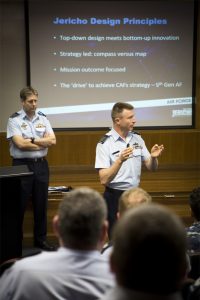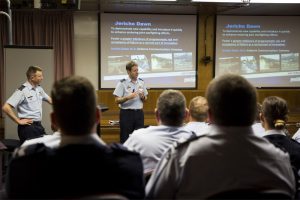2017-09-06 By Robbin Laird
During my visit to Australia last Spring, I discussed the evolution of Plan Jericho with the do-leads of Plan Jericho, Group Captains Campbell and Mitchell.
I had a chance at the end of the Williams Foundation seminar and the following week AFTER the Jericho Dawn exercise to talk with them about the exercise and its place and significance within the Plan Jericho effort.
The exercise involved changing how the air and ground communicated with one another in the maneuver space. As such, the exercise could seem to be a look at new technologies to connect the force.
But this would miss the real point of the effort, which is the reshaping the concept of operations and the co-evolution of the ground and air forces.
And the reshaping effort requires an ongoing operational training regime to understand what further changes are required to ensure that the air-ground maneuver forces work in an effective manner.
It is about technological enablement, but changing the culture and approach of the forces as they work the new technology into new approaches.
The focus of that interview was upon the challenges of working through C2 innovation to get better force structure operational capabilities.
During my most recent visit, I had a chance to sit down at Russell with the new co-lead, Group Captain Carl Newman and Group Captain Mitchell.
In various articles which we have recently published on Second Line of Defense, we have highlighted barriers to getting the kind of 21st century combat force we need to deal with the threats which come at us in high intensity warfare.
Not only have we launched a Forum to deal with the challenge of shifting from slo mo to high intensity warfare, but we have been highlighting in some of our recent interviews some of those challenges.
One of those is clearly the fragmented and cumbersome security system which places layers of players in place and ensures that we will not achieve the kind of C2 in a dynamic threat environment which our forces will need.
For example, during our recent visit to the Naval Air Warfare Development Center at Fallon, we discussed with many of the participants the security challenge and the critical necessity to shape a new approach.
 Director Plan Jericho, Group Captain Pete Mitchell (right) briefs personnel attending the Senior Airman Conference held at the Air Warfare Centre, RAAF Base Williamtown. August 2017. Credit: Australian Department of Defence
Director Plan Jericho, Group Captain Pete Mitchell (right) briefs personnel attending the Senior Airman Conference held at the Air Warfare Centre, RAAF Base Williamtown. August 2017. Credit: Australian Department of Defence
Group Captain Peter Mitchell, co-head of the Jericho project, speaking on the second day of the RAAF Airpower Conference, March 16, 2016.
We concluded during that visit the following with regard to this challenge:
One of the critical advances in the coming together of many 21st Century technological advances is the exponential growth in ISR (Intelligence, Surveillance and Reconnaissance) is a critical component of a countries military battle planning and execution, and that can be a very good thing.
However, what we picked up at Fallon builds on some of the comments we heard in our visit to the Navy Jax, P-8, Triton community.
To put it in our words the “mechanics” of getting actionable timely intelligence to the aircrews and Fleet commanders is often a weak link. The “Intel” can be there but the process is often not helpful. It can be both a macro issue and a micro issue.
On a “macro” level there is a move to send “Intel” up first to higher command then back down. This challenge was discussed at Jax Navy in the context of declaring Triton ocean surveillance information part of a national strategic collection effort. Of course it is an easy solution to let the Intel flow both up and down concurrently.
Hopefully this is in work toward a successful resolution.
The conversation with the Plan Jericho co-leads started with this security challenge.
“One of our challenges is the security and policy framework needed to engage at the appropriate level with our Joint colleagues in shaping a transformation approach.
“Plan Jericho is addressing some of these challenges and sees as a key way ahead getting much greater integration between the air, land and naval forces.
“But this will not happen if we cannot reshape our security processes and approaches.
“We need to cross-pollinate across the various elements of the force structure to get the kind of operational integration which we need.”
“We need to shape the kind of cross platform Training, Tactics and Procedures (TTPs) which allow for and can accelerate integration.
“We have done that on a case by case basis but have not figured how to do that across the board or at the strategic level.”
“We are talking about the joint space, where we have influence but not ownership.
“We need to consider revolutionary innovation concepts, not the biological build approach which we are pursuing.
“The RAAF could pursue revolutionary concepts but if everyone else is pursuing evolution we will have significant gaps in our approach to achieve the kind of operational integration which we will need.”
Laird: At the end of the day, we’re talking here about changing authorities.
We’re recognizing the technologies can talk to each other, for example Wedgetail with Naval radars,
This needs to happen so that the ability of the machines to talk with one another, can unleash the man-machine relationships which we will need for high intensity conflict.
We talk about man to machine, but it’s machine to machine that we’re unleashing as well.
Then we’re changing what the man does with the machine to machine conversation.
We can make this sound harder than it is, but at the end of the day, you start with things Wedgetail or Growler talking with your new naval radars and you are going down the transformation path.
The Plan Jericho Team: Absolutely.
We can see that.
 Directors Plan Jericho, Group Captain Pete Mitchell (left) and Group Captain Carl Newman, brief personnel attending the Senior Airman Conference at RAAF Base Williamtown.August 2017. Credit: Australian Department of Defence
Directors Plan Jericho, Group Captain Pete Mitchell (left) and Group Captain Carl Newman, brief personnel attending the Senior Airman Conference at RAAF Base Williamtown.August 2017. Credit: Australian Department of Defence
One of the barriers that we see at the moment is the security and policy framework that actually prevents that from happening.
We see progress along these lines within Air Force, but we need ensure we can work with the Navy and Army as well to establish a joint framework.
Laird: It seems that the E7 is really a forcing function aircraft for you in this overall effort to rework TTPs to get more joint integration.
Recently, for example, the F-22s in Australia worked closely with Wedgetail to expand their capabilities to work together.
There are examples that have already been demonstrated and it seems this aircraft and its evolution is especially useful in the kind of approach which you are taking with Plan Jericho.
The Plan Jericho Team: That is a good point.
The E7 has significant potential and we need to ensure we establish a roadmap and growth path that meets the joint force needs and then leverage that growth path as a key driver for much of Air Force’s airborne integration efforts.
Laird: So in effect, you need to have a fifth generation security system to go along with the platforms shaping a fifth generation air force, and in this case the Australian owned Wedgetail is a key enabler and forcing function system.
In this case, it is far more than simply a platform.
The Plan Jericho Team: What we’re actually looking at within Jericho next is defining and distilling what the key themes, concepts, and characteristics and risks are to shaping a fifth-generation force.
“What are the defining characteristics?”
“If we can define those, then we have the opportunity to actually have a revolutionary look at security, logistics, integrated tactics and even what a 5th Gen workforce needs to look like.
“At the recent Williams Foundation Seminar on Electronic Warfare, Group Captain Glen Braz hammered home the point that we need to view Growler as part of the joint force, not as supporting the joint force.
“And making that the reality is the challenge.
“And part of what we need to address is leveraging the forcing function of such efforts as Growler integration to reshape the security piece.
“We see the Air Warfare Centre as an important piece of working the key problems of joint TTPs beyond the single platform.
“We’re not just building on what we’ve currently done.
“We’re actually looking at developing tactics in a more integrated manner.
“And this approach is something we are looking to permeate through our force.
“For example, the Growlers are collocated with our Super Hornets.
“We need to see how to integrate these assets.
“The Growler is a very different payload asset; the Super Hornet community can not simply operate in a legacy manner as a kill chain.
“We need to shape a kill web and clearly Super Hornet and Growler integration is part of the equation.
“And we are not simply inheriting approaches born elsewhere outside of Australia in this domain.
“And a major piece of the effort is about training the right kind of workforce.
“We need to shape a workforce very open to the kind of integration we are talking about here and indeed demanding further progress as part of the professional lives.”
Editor’s Note: It should be also noted that the past heads of Plan Jericho have moved on and are continuing to help shape a transformation process.
Air Commodore Rob Chipman is now Director General of Capability Planning within the RAAF. In this capacity, he is taking the Jericho approach into shaping a way ahead for capability planning within the joint force.
Air Commodore Andrew ‘Jake’ Campbell is now Deputy Commander of the Joint Task Force on Operation Sovereign Borders working with Australian Customs and Border Protection agencies against illegal immigrants.
For earlier discussions of Plan Jericho, see the following:
https://sldinfo.com/plan-jericho-shaping-a-transformed-training-system/
https://sldinfo.com/plan-jericho-the-raaf-shapes-a-transformation-strategy-2/
https://sldinfo.com/the-evolution-of-the-raafs-air-mobility-group-its-contribution-to-plan-jericho/
https://sldinfo.com/the-air-commander-australia-discusses-plan-jericho-and-the-way-ahead/

